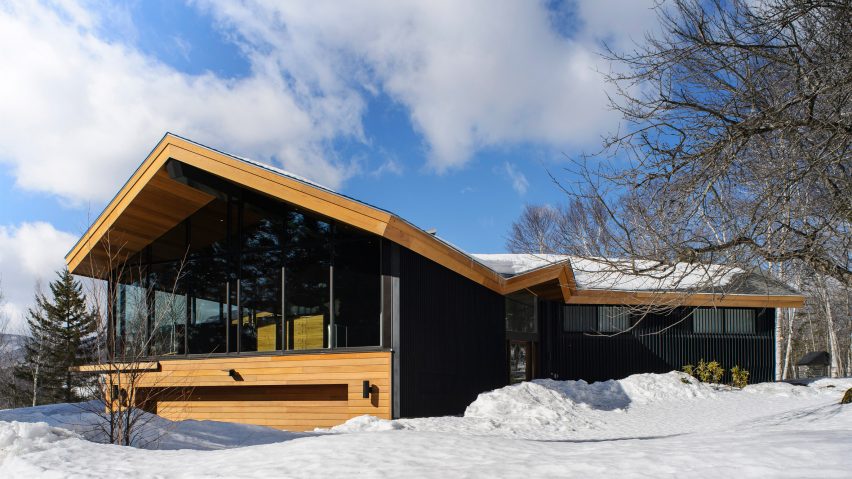Boston-based J Roc Design has built a Vermont home with three wings around a central hub, creating a wheelchair-accessible upper level that spreads across a hillside.
The Glass Trefoil House is situated outside Stowe, Vermont. Recessed into a slope, the upper storey sits elevated to offer a panorama of rolling hills surrounding the valley town.
The home was built from a preexisting foundation, which included a triangular hearth. When redesigning the structure, the architects extended the edges of the triangular element into square wings.
"The house was reimagined using the hearth as a structural and narrative core," said J Roc Design.
"The three-sided hearth produces a continuous trefoil path through each wing of the house, and provides a central anchor while allowing for the house to spread into the landscape."
The lower level features an identical, three-lobed layout. A staircase made of wood and steel wraps around the southeast corner of the hearth, connecting the two levels.
The building's programme is divided among the different protrusions of the plan.
In the basement storey, a garage occupies the south wing. A game room takes up the northwest section, while the remaining extension accommodates two bedrooms and a sauna.
The main floor provides for a kitchen and dining room in the south protrusion. A door at the room's northwest corner leads out onto a terrace that wraps around the northwest lounge, and ends in the master bedroom within the northeast section.
Floor-to-ceiling glazing that surrounds the upper storey floods the living areas with natural light.
Aiming to enhance the scenery, the firm used minimally inserted glass panes that reference the light-installation artworks by American artist James Turrell.
"To perceptually bring the incredible view into the interior, we borrowed from the method of James Turrell's skyspaces," the firm said. "A square of open sky appears as a flattened image through the total reduction of the frame edge."
The lack of framing contributes to a motif across the upper level – the firm did away with structural indications of transitions between the inside and outside.
Along with the fluid circulation of the layout, the absence of such elements helps to accommodate the client's elderly parents and is consistent with their ageing-in-place philosophy.
"To allow for uninterrupted wheelchair access, thresholds, sills, and teak shower pans are flush, and the entire trefoil circulation path is accessible, broad, and clearly defined," the architects said.
Furthermore, sliding doors and granite tiling help to ease wheelchair movement across the level.
Above the black floors, a mid-toned gabled ceiling helps to reflect the much of the natural light. The dark palette offsets the weightlessness of the abundant glazing.
Aiming to achieve a similar balance in the floor below, the architects white-washed the walls and ceilings to counterpoise the black-carpeted floors.
Light-wood finishes and windows set along the upper register of the walls further help to brighten the basement.
Several other homes take advantage of the scenery and seclusion Vermont offers, including another multi-generation family residence perched within a forest clearing and a group of cottages that sit along the foothills of the Green Mountains.
Project credits:
Design: Jeremy Jih
Contractor: Cypress Woodworks
Engineering: Harris Structural Engineering

